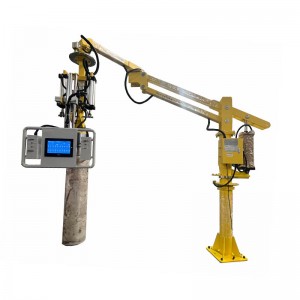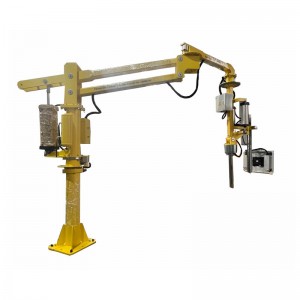A roll handling manipulator is a specialized type of industrial manipulator or lift-assist device designed specifically to lift, rotate, and transport heavy, cylindrical rolls of material. It’s an ergonomic solution used to move rolls of film, paper, textiles, wire, and other materials safely and efficiently, eliminating the strenuous and hazardous manual labor involved.
These manipulators use a rigid arm and a customized end-of-arm-tooling (EOAT) to grip the roll, often from its core, to allow for precise positioning and a “zero-gravity” feel for the operator.
How It Works
The core of a roll handling manipulator’s function is its gripping mechanism and power-assist system:
- Grasping the Roll: The manipulator’s EOAT is specifically designed to handle rolls without damaging their outer layers. Common gripping methods include:Lifting and Balancing: The manipulator’s power system (typically pneumatic or electric servo) counterbalances the weight of the roll and the arm itself. This allows the operator to lift loads weighing hundreds or even thousands of pounds with very little force.
- Core Gripper/Mandrel: An expandable mandrel or plug is inserted into the roll’s inner core. When activated (pneumatically or electrically), it expands to create a strong, secure grip from the inside.
- Clamp/Jaws: For certain rolls, a clamping mechanism with cushioned jaws grips the roll’s outer diameter.
- Forks/Spike: For lighter rolls or those with strong cores, a simple fork or spike can be inserted into the core.
- Rotation and Positioning: A crucial feature is the ability to rotate the roll 90 degrees or more. This allows operators to pick up a roll lying horizontally on a pallet and then turn it vertically to be loaded onto a machine shaft.
- Movement: The entire system is typically mounted on a portable base, a floor-standing column, or an overhead rail system to give the operator a defined work area and reach.
Key Advantages
- Improved Safety and Ergonomics: It completely removes the need for manual lifting, twisting, and awkward postures, which drastically reduces the risk of musculoskeletal injuries.
- Increased Productivity: A single operator can perform tasks that would otherwise require multiple workers. This speeds up material changeovers and reduces downtime.
- Damage Prevention: The specialized EOAT grips the roll securely without damaging its delicate outer layers, which is crucial for expensive or sensitive materials.
- Versatility: With interchangeable EOATs, one manipulator can be adapted to handle rolls with different core diameters, weights, and materials.
Common Application
Roll handling manipulators are indispensable in industries where large quantities of rolled materials are used.
- Converting & Packaging: Moving rolls of plastic film, paper, foil, and labels for loading onto slitting, printing, or packaging machines.
- Textiles: Handling heavy rolls of fabric or nonwoven materials.
- Printing: Lifting and positioning massive rolls of paper for printing presses.
- Paper & Pulp: Manipulating large and heavy rolls of paper.
- Automotive: Handling rolls of rubber, upholstery, or other materials used in vehicle production.
Thanks for reading! I’m Loren, responsible for the global automation equipment export business at Tongli Industrial.
We provide high-precision loading and unloading manipulator robots to help factories upgrade to intelligence.
If you need product catalog or customized solution, please contact:
Email: manipulator@tongli17.com | Mobile Phone: +86 159 5011 0267
Post time: Aug-11-2025




